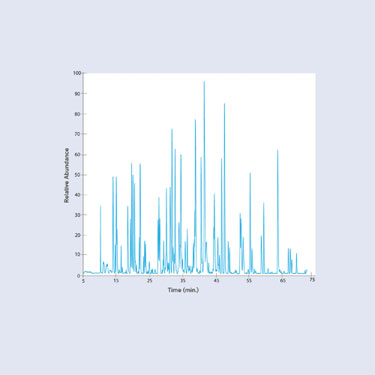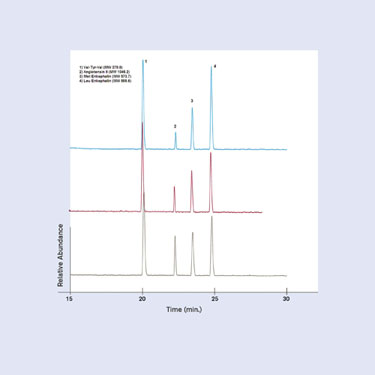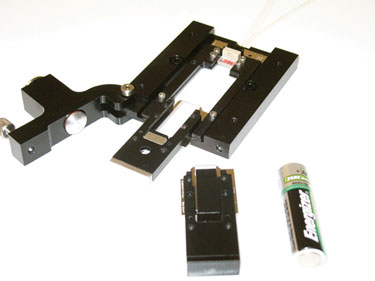January 1, 2010 (Vol. 30, No. 1)
Don W. Arnold Ph.D.
Use of Microfluidics in Biological and Biochemical Laboratories Is on the Rise
Tremendous effort is currently dedicated to identifying protein-based biomarkers that can be used to diagnose disease and/or monitor a patient’s health. Whether one uses a top-down or a bottom-up approach, nanoLC-MS has become a preferred tool for identification of proteins. This technique provides a high degree of selectivity and reliably identifies multiple sample components in a complex mixture. In typical nanoLC-MS experiments the mixture is separated based on one or more selected chemical properties (charge, hydrophobicity, affinity, etc.) followed by detection and fragmentation steps in the mass spectrometer.
Early nanoLC-MS research relied on conventional HPLC systems fitted with homemade flow-splitters to deliver nL/minute flow rates to the separation column. Commercial systems based on this approach often suffered from poor precision. Column blockages, which affected the flow rate, were common.
Microfluidics technologies enabled a number of bioanalytical advancements. This engineering discipline employs precise, flexible microfabrication techniques to create innovative micro- and nanoscale fluid delivery, manipulation, and analysis technologies. By addressing common challenges to nL-volume sample manipulation such as evaporation, adsorption, and precipitation, researchers developed microfluidics tools that provide a workable alternative to traditional laboratory equipment.
The early microfluidic efforts of some developers focused on fabrication of an HPLC-on-a-chip. Progress, however, was hindered by technological challenges in fabrication, materials, and connections. As a result, most microfluidic efforts shifted to nonHPLC methods—typically low-pressure methods that employ voltage-controlled fluid manipulation via electro-osmosis.
In 2003, Eksigent pioneered a fundamental shift in nanoscale pump technology by delivering the first commercially successful direct-pumping nanoLC system. By incorporating a control algorithm that measures the flow rate accurately many times per second and by providing feedback to the direct-pumping system, retention times were controlled with analytical precision at low flow rates. Since that time, many manufacturers have switched to direct-pumping mechanisms to deliver the precision, reliability, and low-solvent consumption required for modern nanoLC-MS experiments.
NanoLC-MS uses capillary columns, which have remained a significant source of variability, with poor column-to-column performance. Additionally, a high skill level is required to use capillary columns and make the required low-volume connections. Connecting the column to the fluid delivery system, trap columns, and valves requires that users be skilled in the art of cutting silica capillary and fitting it into compression fittings so that the dead volume is minimized. Time-consuming testing processes are required and the failure rate is high.
As biomarker experiments move to verification and, ultimately, to the clinical validation stage, larger numbers of samples must be reliably evaluated. Reproducibility considerations become critical and system ease-of-use is essential for routine operation.
Advancements in microfluidic technology have enabled developers to again focus on chip-based HPLC systems to address precision challenges.
Eksigent’s proteomics platform, the cHiPLC-nanoflex, is designed to facilitate the replacement of different nanoLC columns, traps, etc., and deliver improved precision and workflow flexibility. Engineered to be used between the Eksigent nanoLC fluid delivery system and a mass spectrometer, the cHiPLC-nanoflex module houses three EksPort connector docking stations (with temperature control for improved performance) and a 10-port valve that is preplumbed at the factory.
The system is compatible with most mass spectrometers through the manufacturer’s nanospray interface. Additionally, the system’s architecture allows researchers to switch between workflows. Depending on which chip set is installed in the system, the researcher can carry out direct inject, dual-column direct inject for higher throughput or trap-and-elute experiments with minimal effort for the switchover.
While there are many approaches and materials available for making microfluidic devices, the cHiPLC-nanoflex chips are made using standard cleanroom-based semiconductor manufacturing techniques with fused silica as the material of choice. By using microfabrication techniques to form the capillary channel and frit in a silica substrate, parts are made in a precisely controlled, scalable batch process to reduce column-to-column variability. Fused silica is chosen as the material for its mechanical strength, excellent chemical compatibility, optical transparency, and microprocessing characteristics.
As with computer-chip manufacturing, the microfluidic chips are manufactured in wafer form, then separated at the end of the batch fabrication process. Depending upon the chip functionality, either two, three, or four pattern-and-etch cycles are completed using standard lithography techniques. Wafers are bonded together using precise alignment, direct bonding, and high-temperature thermal annealing processes. This produces exceptionally smooth, cylindrically shaped channels inside the devices for improved chromatographic performance.
It is critical that the connections do not degrade performance of the overall system and reduce the data quality. The Eksigent EksPort microconnector system (Figure 1) enables researchers to change columns and traps with a motion that is similar to inserting a thumb drive for a computer. The connector system has sub-nL dead volumes that are automatically aligned so that chromatographic dispersion is minimized, even when sample passes through several connections.

Figure 1. The EksPort microconnector system enables column and trap changes with a motion that is similar to inserting a thumb drive on a computer.
The EksPort connector allows researchers to realize the performance advantages of microfluidics and also separates components that have different replacement schedules.
A separation of a BSA digest sample (Figure 2) shows that the system delivers state-of-the-art chromatographic performance in a format that is much easier to use. For this separation, a 15 cm x 75 µm chip column (ChromXP-C18 CL; 3 µm; 300 Å pore size) was used; the separation was accomplished using a 0.5% ACN/minute gradient at 250 nL/min.

Figure 2. Separation of a BSA digest on a nano cHiPLC column of 15 cm x 75 µm, packed with ChromXP C18-CL 3 µm 300 Å.
Additionally, the chips deliver tight reproducibility, providing chip-to-chip (i.e., column-to-column) retention time variability of less than 2%. Three different 15 cm x 75 µm chip columns (ChromXP C18-CL, 3µm, 300 Å) were used to separate a four-component peptide test mix (Figure 3) using a 2% ACN/minute gradient delivered from a nanoLC-Ultra-2D Plus nanoLC system.
Microfluidics technologies deliver better results through their ability to leverage the advantages of fundamental microscale and nanoscale phenomena. Microfluidics are particularly attractive for biological and biochemical applications. The recent advances in microfluidic technology promise to deliver exciting new capabilities for improved precision, higher throughput, and improved ease-of-use for nanoLC-MS techniques and will facilitate much broader implementation of the technology.

Figure 3. Excellent intercolumn reproducibility is achieved for a peptide test mix between 15 cm x 75 µm nano cHiPLC columns packed with ChromXP C18-CL 3 µm 300 Å.
Don W. Arnold, Ph.D. ([email protected]), is founder and vp at Eksigent Technologies. Web: www.eksigent.com.







